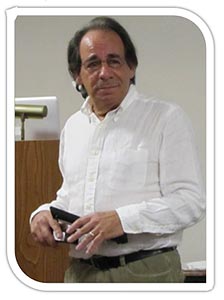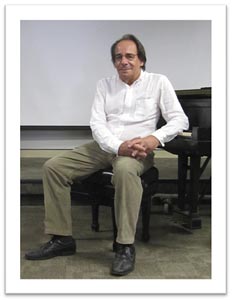Music Educators Association of New Jersey
Serving teachers and students since 1927



This was the intriguing title for the presentation by James Irsay - pianist, musicologist and a host at WBAI 99.5 FM in New York.

Mr. Irsay has encyclopedic knowledge and specializes in historical recordings with an emphasis on piano music. He studied with world-class performers and composers Jorge Bolet, John Ogdon, Sasha Gorodnitzki, Peter "PDQ Bach" Schickele and Jacob Druckman. He has performed with Itzhak Perlman, Pinchas Zuckerman, Raymond Lewenthal, Alan Titus, and many more musical luminaries. His work at WBAI has received wide recognition, including The Major Armstrong Award, several Corporation for Public Broadcasting Awards, and for National Public Radio, The Ohio State Award.
In his opening statement, Mr. Irsay stated 'There is a limit to mere beauty: sound, pedaling, technique might be almost perfect, but there is no soul. There should be a musical statement, narrative, like in a novel.' To illustrate, he played a recording of Chopin's Nocturne in B minor. The recording was very clean, but had nothing special; Mr. Irsay subsequently analyzed the 'missed opportunities'. He didn't want to name the performer, except to say she was a 16-year old from the recent Chopin Competition. In contrast, he played two recordings of the same piece by Raul Koczalski (student of Anton Rubinstein and Karol Mikuli, who, in turn, had studied with Chopin himself) and by Leo Sirota (a student of Paderewski and Busoni). In each case, this Nocturne sounded highly individual, with surprisingly beautiful voicing and deep artistic nuances, as if it were not 'learned', but improvised.

Then Mr. Irsay played three different versions of the opening bars of Beethoven's 'Emperor' Concerto. Van Cliburn was very good, but something was missing; Joseph Hoffman (a student of Ignatz Friedman) had much more meaning and inspiration; Ernest Hutcheson was different from Hoffman, but equally expressive.
Mr. Irsay illustrated that the concept of 'perfectly correct' playing is not what great composers and musicians were and are looking for. Next we heard Bach's Violin Sonata in G minor played by George Enescu in 1948 and Isaak Stern in 1962. Enescu was more Romantic and there was color in every note. Stern was more 'modern' with sharp edges between the chords and somewhat less expressiveness.

Mr. Irsay played Mendelssohn's Songs without Words Op. 36 No. 6 and No. 2 by Joseph Hoffman. Each voice was personalized and there was a sense of orchestral playing with different instrumental timbres. Although Mr. Hoffman followed the composer's notation, there was a distinct individuality in interpretation. This is what all composers really want!
We also heard interpretations of Brahms' Intermezzo in A-flat Op. 76 No. 3: by Myra Hess - the gentlest sound, like a lullaby; Carl Friedberg - gracefully expressive; and by Hungarian pianist Etelka Freund - here follows Mr. Irsay's description as an example of his unique and engaging analysis:
"The recording was made in 1951. A very unorthodox interpretation to our ears, but orthodoxy is not necessarily the answer, and not necessarily "authentic". Orthodoxy is a result of a process passed along through time by performers (and by apostles of various schools!). It is ironic that an interpretation we hear as "unorthodox" was influenced and guided by the composer. That's not to say the composer played the Intermezzo like his young friend Etelka Freund did, to whom he was an admiring mentor. But her freedom, ease and momentum were qualities that were often observed in Brahms' playing. An approach may be applied to widely disparate interpretations."

Mr. Irsay stressed that there is a kind of mummification of Brahms and other composers, going so far as to check exact timing of performances. We should be immersed in the actual message of the music. He illustrated all the musical examples with scores and emphasized that part of musical education today should be listening to the old masters.
'Morning Irsay' can be heard at WBAI.org or 99.5 FM on Fridays from 10:00 a.m. to noon. In his broadcast of Friday October 16 (following the MEA meeting), Mr. Irsay mentioned the MEA presentation several times and he also thanked the MEA for the invitation.
Written by Sophia Agranovich,
Program Chair and Hostess
Photography and layout, Nancy Modell